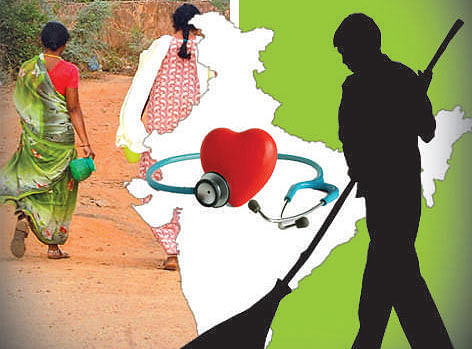
That the Union government has accorded high priority to ‘swachhata’ deserves cheer. But lest it is forgotten, previous governments had also given similar priority to sanitation under the aegis of the “Total Sanitation Campaign” which started in 1999. Although the 15-year graph of toilets constructed by the states is impressive, it has, nonetheless, left nearly half of India defecating in the open.
The ministries of drinking water and sanitation, and urban development, the World Bank, UNICEF, prominent bilateral agencies, philanthropists and countless NGOs have been trying to get Indians to build and use toilets through all these years.
Yet, the census shows that rural sanitation is just 31 per cent and Jharkhand, Madhya Pradesh, Odisha, Bihar, Rajasthan and Uttar Pradesh (in that order) are among those with the worst standard of sanitation. It is not as though the educated South is much better as Tamil Nadu and even Karnataka have far to go, having fallen behind the national average. Toilet use in urban areas in the country is better but still lags far behind the standards of poorer countries like Bangladesh.
Over the years, the Ministry of Drinking Water and Sanitation has judged success of the programme by the number of latrines built and the number of villages awarded the Nirmal Gram Puraskar for becoming open defecation-free.
This, despite the known fact that money spent on spreading awareness and building toilets has often led to highly unsatisfactory utilisation outcomes, exacerbated by the lack of water and astonishingly, an individual preference for open defecation.
The Swacch Bharat programme, therefore, presents an opportunity for doing things differently — but only if the challenges are confronted imaginatively and not by short-lived attempts to wield the broom before cameras. And if the new programme is implemented without rewards and retributions for key functionaries and citizens, this too will become like many other bureaucratic ventures — banal and boring.
Starting June this year, a slew of international articles supported by research papers from public health experts hammered India for failure to contain open defecation, exacerbated by a burgeoning population prone to malnutrition, stunting and succumbing to diarrhoeal diseases.
Public health reports have been unanimous in showing how bacteria and worms get ingested through the faecal-oral route, largely the result of open defecation and unhygienic disposal of human excreta. As a result, it is the most vulnerable – mainly young children - who become incapable of absorbing calories and nutrients and are rendered victims of malnutrition, stunting and diarrhoeal diseases.
The use of toilets must therefore be monitored without using the right tools and asking the right questions: whether there was a decline in water-borne diseases after a village got access to toilets? Did deaths of children under 5 (the most at-risk segment) reduce? Did malnutrition levels come down? The health ministry’s expert institutions conduct surveys on all these subjects but as long as sanitation is considered to be another department’s responsibility, issues of turf will prevent fresh thinking and reporting.
Swacch Bharat can sweep out decade old mindsets and augur in a new way of judging success and equally failure. But that requires a shared vision to improve health indices as the first priority and not let sermons and construction statistics detract from the primary focus.
Access to sanitation
While urban areas may look better placed compared to rural areas as more than an 80 per cent provision of toilets is reported, the capital city of Delhi (one of the better cities) has considerable open defecation. Social studies show that people feel that squatting is for free and the disposal of excreta flowing into water is “clean business”.
In any case, the daily defecation into the Yamuna is considered a miniscule addition to the huge quantities of untreated sewage which have already choked the river for years. Importantly, slum households living besides the riverbed do not consider access to sanitation among their top list of household priorities (TVs and mobiles matter more).
But swatchhata is not only about latrines. It also includes towns and cities with clean surroundings, where debris, garbage and construction rubble make the citizen’s life miserable. No miscreant ever gets fined for creating a nuisance even as the municipal staff and police jointly lament that the fines are too low and the possibility of punishment too remote for citizens to be deterred.
That being so, whether it is rural India or urban, the Swachh Bharat programme needs to make structural changes in the way supervisory responsibilities are apportioned. Sanitation outcomes need to be judged by factors which are germane to the fundamental aim of sanitation which is to promote public health and improve civic conditions.
In rural areas, reducing diarrhoeal outbreaks, malnutrition and under-5 child deaths should become essential end- products of the sanitation campaign as much as the construction of toilets itself. Open defecation must be viewed by society as something intolerable, to be spurned by all.
The invocation of the Mahatma’s name and our ancient adages about swacchata may not motivate poor households as much as economic solutions like night-soil based bio-gas plants (which are functioning in villages in Pune district supplying cooking gas to households) might stimulate change.
When it comes to urban spaces, fines must be raised drastically by altering the schedule to the Municipal Corporation of Delhi Act is something the urban development ministry can authorise overnight. Making the fine payable on-the-spot or by having to appear before an executive magistrate who can triple the fine or add it to the property tax bill in case of default would have visible impact.
It is time swachhata was judged by healthier, safer lives and not just by counting latrines. Two key ministries have a great chance to do things differently.
(The writer is former chief secretary, Delhi)